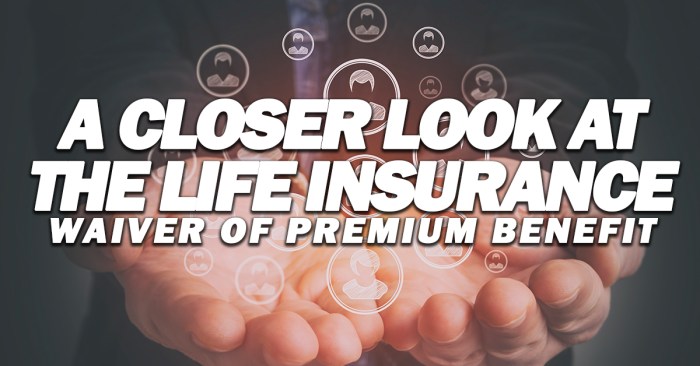Life insurance provides crucial financial security for loved ones, but unforeseen circumstances like illness or job loss can disrupt premium payments, potentially jeopardizing the policy’s coverage. This is where the waiver of premium benefit becomes invaluable. This benefit acts as a safety net, ensuring your life insurance policy remains active even if you face unexpected financial hardship, allowing you to maintain vital coverage without interruption.
This guide delves into the intricacies of waiver of premium benefit life insurance, exploring its definition, eligibility criteria, various types, financial implications, and limitations. We’ll examine how this benefit interacts with other policy features and compare it to other life insurance riders. Through real-world examples and hypothetical scenarios, we aim to provide a clear and comprehensive understanding of this important policy provision.
Definition and Explanation of Waiver of Premium Benefit

A waiver of premium benefit is a valuable rider—an add-on—to many life insurance policies. It essentially provides a safety net, ensuring that your life insurance policy remains in force even if you experience an unforeseen event that prevents you from making premium payments. This protection is crucial because a lapsed policy means the loss of valuable coverage, leaving your beneficiaries vulnerable.
This benefit protects policyholders from the financial burden of unexpected events that could lead to policy lapse. By eliminating the need for premium payments during a specified period, the waiver of premium rider helps maintain continuous coverage, providing peace of mind knowing your loved ones will be financially protected regardless of your ability to pay.
Qualifying Events for Waiver of Premium
The specific events that trigger a waiver of premium vary depending on the insurer and the policy. However, common qualifying events typically include total and permanent disability. This usually means the insured is unable to perform any occupation due to a covered illness or injury. Some policies may also include specific critical illnesses, such as cancer, heart attack, or stroke, as qualifying events. It’s crucial to carefully review the policy’s specific terms and conditions to understand precisely what events qualify for a waiver of premium. For example, a policy might specify that the disability must last for a certain period, such as six months, before the waiver takes effect. Other policies might have stricter definitions of disability, requiring proof of inability to perform any gainful occupation, while others may be more lenient, considering the inability to perform one’s own occupation.
Waiver of Premium Across Different Life Insurance Types
Waiver of premium benefits are available with various life insurance products, including term life, whole life, and universal life insurance. However, the availability and specific terms of the benefit can differ significantly across these types. For instance, a term life insurance policy with a waiver of premium rider might only cover disability occurring during the policy’s term. Conversely, a whole life policy with this rider might offer lifelong coverage, regardless of when the disability occurs. Universal life insurance policies often offer flexibility in this area, allowing policyholders to choose the level of coverage and the specific conditions under which the waiver applies. The cost of the rider, as a percentage of the overall premium, can also vary based on the type of life insurance and the insured’s health and age. For instance, a younger, healthier individual might secure the rider at a lower cost compared to an older individual with pre-existing health conditions.
Eligibility Criteria and Requirements
Securing a waiver of premium benefit typically involves meeting specific criteria set by the insurance provider. These requirements ensure the benefit is awarded fairly and appropriately to those who genuinely need it. Understanding these stipulations is crucial for policyholders to assess their eligibility and plan accordingly.
Common Eligibility Criteria
Generally, eligibility for a waiver of premium benefit hinges on the policyholder experiencing a total and permanent disability. This usually means the individual is unable to perform any occupation for which they are reasonably suited by education, training, or experience. The definition of “total and permanent disability” can vary slightly between insurance providers, so careful review of the policy’s specific wording is essential. Some policies may also include provisions for waivers due to specific critical illnesses, such as heart attacks or strokes, depending on the policy’s terms and conditions.
Waiting Periods
A waiting period is a common feature of waiver of premium benefits. This is a period of time, typically ranging from 90 days to a year, that must elapse after the onset of a qualifying disability before the benefit becomes effective. This waiting period helps to mitigate against short-term or temporary disabilities triggering the benefit. For example, a policy might require a continuous period of disability for six months before the waiver of premium takes effect. The length of the waiting period is usually stipulated in the policy documents.
Impact of Pre-existing Conditions
Pre-existing conditions can significantly impact eligibility for a waiver of premium benefit. Many insurance policies exclude coverage for disabilities or illnesses that existed before the policy’s effective date or within a specified period before the policy was issued. For instance, if an individual had a heart condition before purchasing the insurance and subsequently suffers a heart attack, the waiver of premium may not apply because the condition was pre-existing. The policy’s specific definition of “pre-existing condition” and any associated exclusions should be carefully examined.
Hypothetical Application Scenario
Imagine Sarah, a 40-year-old teacher, has a life insurance policy with a waiver of premium benefit. After a car accident, she sustains injuries that leave her permanently unable to teach. Sarah’s policy has a 90-day waiting period and defines total and permanent disability as the inability to perform any occupation for which she is reasonably suited. To claim the waiver, Sarah must provide medical documentation from her doctor confirming her disability and its permanence, along with evidence showing the disability occurred after the 90-day waiting period. The insurance company will then review her claim to determine its eligibility based on the policy’s terms and conditions. If approved, her premiums will be waived for the duration of her disability.
Types and Variations of Waiver of Premium Benefits

Waiver of premium benefits aren’t all created equal. Insurance companies offer a variety of these benefits, each with its own nuances in terms of eligibility, coverage, and limitations. Understanding these variations is crucial for selecting a policy that best suits your individual needs and circumstances. This section will explore some common types and highlight their key features.
Different types of waiver of premium benefits cater to various situations and policy structures. The key differences often lie in the triggering event, the duration of coverage, and any associated limitations or exclusions.
Common Types of Waiver of Premium Benefits
| Benefit Type | Description | Eligibility | Limitations |
|---|---|---|---|
| Total and Permanent Disability Waiver of Premium | This is the most common type. Premiums are waived if the policyholder becomes totally and permanently disabled, as defined by the policy. This typically requires proof of disability from a physician, and the definition of “total and permanent” can vary between insurers. | Typically requires proof of total and permanent disability preventing the insured from performing any gainful occupation. Specific definitions vary by insurer. | The definition of “total and permanent disability” can be restrictive. There might be a waiting period before benefits begin. The waiver may only apply to the death benefit portion of the policy, not additional riders. Some policies may have a maximum duration for the waiver. |
| Partial Disability Waiver of Premium | Less common, this benefit waives premiums if the insured experiences a partial disability that prevents them from performing some, but not all, of their job duties. The definition of “partial disability” is usually more stringent than “total and permanent disability”. | Proof of partial disability preventing the insured from performing a significant portion of their job duties, as defined in the policy. This often requires documentation from a physician and potentially an independent medical examination. | More restrictive eligibility criteria than total and permanent disability waivers. May have shorter durations or lower payout percentages. The policy may require a specific percentage of income loss to qualify. |
| Accidental Disability Waiver of Premium | This type waives premiums only if the disability results from an accident. Illnesses are typically excluded. | Proof of disability resulting from an accident, usually requiring police reports and medical documentation. | Only covers disabilities caused by accidents, excluding illnesses or other causes. May have a shorter duration of coverage than other waiver types. Specific accident types may be excluded. |
| Critical Illness Waiver of Premium | Premiums are waived if the insured is diagnosed with a specific critical illness listed in the policy. This is often bundled with a critical illness rider. | Diagnosis of a specified critical illness by a qualified medical professional, often requiring documentation from the physician. | Only covers the critical illnesses explicitly listed in the policy. The definition of each illness is strictly defined, and the diagnostic criteria must be met. |
Impact on Policy Value and Benefits
The waiver of premium benefit, while offering crucial protection against unforeseen circumstances, does have an impact on the overall value and features of your life insurance policy. Understanding these effects is key to making an informed decision about whether this rider is right for you. This section will explore how the waiver of premium interacts with the policy’s cash value, death benefit, and loan provisions.
The waiver of premium benefit doesn’t directly increase the cash value of your policy. Instead, it protects the existing cash value by preventing its erosion due to unpaid premiums. If you become disabled and unable to pay premiums, the insurer pays them on your behalf, preserving the policy’s cash value and ensuring the continued accumulation of potential benefits. Without the waiver, unpaid premiums would reduce the cash value, potentially leading to policy lapse. The benefit essentially acts as a safeguard, maintaining the policy’s value under specific circumstances.
Interaction with Death Benefit
The waiver of premium benefit does not affect the death benefit amount stipulated in your policy. The death benefit remains unchanged regardless of whether you utilize the waiver or not. This means your beneficiaries will still receive the agreed-upon sum upon your death, even if premiums have been waived due to disability. The waiver simply ensures the policy remains active to pay out that death benefit; it does not alter the benefit itself.
Interaction with Loan Provisions
The availability of policy loans generally remains unaffected by the waiver of premium benefit. You can still borrow against the cash value of your policy, even if premiums are being waived. However, remember that any outstanding loans and interest will reduce the death benefit payable to your beneficiaries. The waiver protects the policy from lapsing due to non-payment of premiums, but it doesn’t eliminate the financial implications of borrowing against the policy.
Financial Implications: Illustrative Examples
Let’s consider two scenarios:
Scenario 1: John has a $500,000 life insurance policy with a waiver of premium rider. He becomes disabled and unable to work. His premiums are waived for two years, totaling $10,000. His policy remains active, maintaining its full $500,000 death benefit and cash value (minus any existing loan).
Scenario 2: Mary has the same $500,000 life insurance policy but without a waiver of premium rider. She experiences the same disability. Unable to pay the $10,000 in premiums over two years, her policy lapses. The death benefit is lost, and her cash value is forfeited.
These scenarios clearly illustrate the financial protection offered by the waiver of premium benefit. While the cost of the rider adds to the overall premium, the potential loss of a significant death benefit and accumulated cash value far outweighs this cost in situations where disability prevents premium payments.
Comparison with Other Life Insurance Riders
Understanding how the waiver of premium benefit interacts with other common life insurance riders is crucial for a comprehensive assessment of your policy’s overall protection. This comparison highlights key distinctions and similarities to aid in informed decision-making.
Several riders augment the core life insurance policy, each offering distinct coverage. Comparing the waiver of premium rider with others helps determine the optimal combination for individual needs and risk profiles. A thorough understanding allows for a more tailored and effective insurance strategy.
Waiver of Premium vs. Accidental Death Benefit
The waiver of premium rider and the accidental death benefit rider serve very different purposes. While the waiver of premium protects against the financial burden of premium payments during disability, the accidental death benefit provides a lump-sum payment to beneficiaries only if the insured dies due to an accident.
- Waiver of Premium: Covers premium payments if the insured becomes disabled, ensuring continued policy coverage without added cost. It doesn’t provide a death benefit increase.
- Accidental Death Benefit: Pays a lump sum (often a multiple of the death benefit) only if death results from an accident. It does not cover premium payments during disability.
Waiver of Premium vs. Long-Term Care Rider
Both the waiver of premium and long-term care riders address potential future financial burdens, but in distinct ways. The key difference lies in the event triggering the benefit payout and the nature of the benefit itself.
- Waiver of Premium: Focuses on maintaining life insurance coverage during disability by covering premium payments. It does not provide funds for long-term care expenses.
- Long-Term Care Rider: Provides funds for long-term care expenses, such as nursing home care or in-home assistance, if the insured becomes chronically ill or disabled. It does not cover life insurance premiums.
Waiver of Premium vs. Critical Illness Rider
A critical illness rider and a waiver of premium rider both offer financial assistance in the face of significant health challenges, but their focus and payouts differ significantly. One addresses ongoing policy maintenance; the other offers a lump sum payment.
- Waiver of Premium: Continues coverage by paying premiums during disability, leaving the death benefit intact.
- Critical Illness Rider: Pays a lump-sum benefit upon diagnosis of a specified critical illness (e.g., cancer, heart attack). This payment can be used for any purpose, including medical expenses or premium payments, but it is a one-time payout.
Final Wrap-Up

Securing your family’s financial future requires careful consideration of all aspects of life insurance. The waiver of premium benefit offers significant peace of mind, safeguarding your policy from unforeseen events that might otherwise disrupt premium payments. By understanding the intricacies of this benefit—its eligibility requirements, limitations, and financial implications—you can make informed decisions to protect your loved ones and your financial legacy. Remember to carefully review your policy documents and consult with a financial advisor to determine if a waiver of premium benefit is the right choice for your individual needs.
FAQ Resource
What happens to the cash value of my policy if the waiver of premium benefit is activated?
The impact on cash value depends on the specific policy. Generally, the cash value continues to grow, although the rate of growth might be affected by the absence of premium payments. Check your policy details for specifics.
Can I add a waiver of premium benefit to an existing policy?
This depends on your insurer and the type of policy you have. Some insurers allow adding riders later, while others may not. Contact your insurer to inquire about adding this benefit to your current policy.
Does the waiver of premium benefit cover all disabilities?
No, it typically covers disabilities that meet the policy’s specific definition, often requiring total disability for a certain period. Pre-existing conditions might also affect eligibility. Review your policy for precise details.
How long is the waiting period before the waiver of premium benefit takes effect?
Waiting periods vary by insurer and policy. It’s commonly a period of 90 days to a year after the policy’s inception before the benefit becomes effective. Consult your policy documents for the exact waiting period.